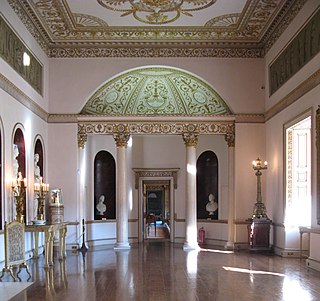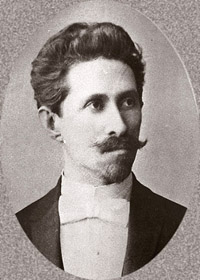
Auguste de Montferrand was a French classicist architect who worked primarily in Russia. His two best known works are the Saint Isaac's Cathedral and the Alexander Column in Saint Petersburg.

Robert Mylne was a Scottish architect and civil engineer, particularly remembered for his design for Blackfriars Bridge in London. Born and raised in Edinburgh, he travelled to Europe as a young man, studying architecture in Rome under Piranesi. In 1758, he became the first Briton to win the triennial architecture competition at the Accademia di San Luca. This made his name known in London, and won him the rivalry of fellow Scot Robert Adam.

Ange-Jacques Gabriel was the principal architect of King Louis XV of France. His major works included the Place de la Concorde, the École Militaire, and the Petit Trianon and opera theater at the Palace of Versailles. His style was a careful balance between French Baroque architecture and French neoclassicism.

The Adam style is an 18th-century neoclassical style of interior design and architecture, as practised by Scottish architect William Adam and his sons, of whom Robert (1728–1792) and James (1732–1794) were the most widely known.

Neo-Byzantine architecture was a revival movement, most frequently seen in religious, institutional and public buildings. It incorporates elements of the Byzantine style associated with Eastern and Orthodox Christian architecture dating from the 5th through 11th centuries, notably that of Constantinople and the Exarchate of Ravenna.

Neoclassical architecture, sometimes referred to as Classical Revival architecture, is an architectural style produced by the Neoclassical movement that began in the mid-18th century in Italy, France and Germany. It became one of the most prominent architectural styles in the Western world. The prevailing styles of architecture in most of Europe for the previous two centuries, Renaissance architecture and Baroque architecture, already represented partial revivals of the Classical architecture of ancient Rome and ancient Greek architecture, but the Neoclassical movement aimed to strip away the excesses of Late Baroque and return to a purer, more complete, and more authentic classical style, adapted to modern purposes.
The year 1708 in architecture involved some significant architectural events and new buildings.
The year 1818 in architecture involved some significant events.

Caspar Frederik (Friedrich) Harsdorff, also known as C.F. Harsdorff, was a Danish neoclassical architect considered to have been the leading Danish architect in the late 18th century.

James Playfair was a Scottish architect who worked largely in the neoclassical tradition.

Marian Marianovich Peretyatkovich was a Russian and Polish architect. His premature death at the age of 43 limited his career to only eight years of independent practice (1908-1916), however, he managed to excel in a rational (Finnish) variety of late Art Nouveau, Renaissance Revival and Russian Revival in Saint Petersburg and Moscow. He is sometimes compared with Louis Sullivan on account of his insistence on functionality of office buildings.

The Cathedral of San Carlos Borromeo, also known as the Royal Presidio Chapel, is a Catholic cathedral located in Monterey, California, United States. The cathedral is the oldest continuously operating parish and the oldest stone building in California. It was built in 1791-94 making it the oldest serving cathedral in the United States, along with St. Louis Cathedral in New Orleans, Louisiana. It is the only existing presidio chapel in California and the only existing building in the original Monterey Presidio.

Alexander Nikanorovich Pomerantsev was a Russian architect and educator responsible for some of the most ambitious architectural projects realized in Imperial Russia and Bulgaria at the turn of the 20th century. An accomplished eclecticist, Pomerantsev practiced Art Nouveau, Byzantine, Russian Revival styles and collaborated with leading structural engineers of his period in creating new types of commercial buildings.

The Benois family was a family of prominent 19th and 20th century Russian artists, musicians and architects, descended from French confectioner Louis Jules Benois (1770/1772?–1822), cook-confectioner to the Duke of Montmorency, who moved to Russia in 1794 after the French Revolution and became a royal headwaiter.

Richard Mique was a neoclassical French architect born in Lorraine. He is most remembered for his picturesque hamlet, the Hameau de la Reine — not particularly characteristic of his working style — for Marie Antoinette in the Petit Trianon gardens within the estate of Palace of Versailles.

David Ivanovich Grimm was a Russian architect, educator and historian of art specialising in the Byzantine Empire, Georgia and Armenia. Grimm belonged to the second generation of Russian neo-Byzantine architects and was the author of Orthodox cathedrals in Tbilisi, Chersonesos and smaller churches in Russia and Western Europe. Grimm was a long-term professor at the Imperial Academy of Arts and chaired its department of architecture in 1887–1892.

French architecture consists of architectural styles that either originated in France or elsewhere and were developed within the territories of France.

Russian neoclassical revival was a trend in Russian culture, most pronounced in architecture, that briefly replaced Eclecticism and Art Nouveau as the leading architectural style between the Revolution of 1905 and the outbreak of World War I, coexisting with the Silver Age of Russian Poetry. It is characterized by a merger of new technologies with a moderate application of classical orders and the legacy of the Russian Empire style of the first quarter of the 19th century.

Russian-Byzantine architecture is a revivalist direction in Russian architecture and decorative and applied arts, based on the interpretation of the forms of Byzantine and Ancient Russian architecture. As part of eclecticism could be combined with other styles.

Neoclassicism is a movement in architecture, design and the arts which emerged in France in the 1740s and became dominant in France between about 1760 to 1830. It emerged as a reaction to the frivolity and excessive ornament of the baroque and rococo styles. In architecture it featured sobriety, straight lines, and forms, such as the pediment and colonnade, based on Ancient Greek and Roman models. In painting it featured heroism and sacrifice in the time of the ancient Romans and Greeks. It began late in the reign of Louis XV, became dominant under Louis XVI, and continued through the French Revolution, the French Directory, and the reign of Napoleon Bonaparte, and the Bourbon Restoration until 1830, when it was gradually replaced as the dominant style by romanticism and eclecticism.


















